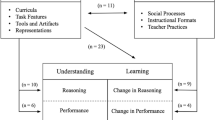ABSTRACT
The aim of this study was to examine how teachers enact the same written algebra curriculum materials in different classes. The study addresses this issue by comparing the types of algebraic activity (Kieran, 2004) enacted in two 7th grade classes taught by the same teacher, using the same textbook. Data sources include lesson observations and an interview with the teacher. The findings show that students in the two classes were offered somewhat different algebraic experiences. At one school, more emphasis was placed on global/meta-level activities (activities that are not exclusive to algebra and suggest general mathematical processes), whereas at the other school, more emphasis was placed on transformational activities (“rule-based” algebraic activities). Analysis of the sources of the differences related to the ways in which the teacher used and enacted the curriculum materials in the two classes revealed that these were linked to the teacher’s attempts to be attentive to the students in the class and to the nature of the students’ work.
Similar content being viewed by others
References
Arcavi, A. (1994). Symbol sense: Informal sense-making in formal mathematics. For the Learning of Mathematics, 14(3), 24–35.
Bednarz, N., Kieran, C. & Lee, L. (Eds.). (1996). Approaches to algebra: Perspectives for research and teaching. Dordrecht, The Netherlands: Kluwer.
Chazan, D. (2000). Beyond formulas in mathematics and teaching: Dynamics of the high school algebra classroom. New York: Teachers College Press.
Cohen, D. K. & Ball, D. L. (2001). Making change: Instruction and its improvement. Kappan, 81(1), 73–77.
Cuban, L., Kirkpatrick, H. & Peck, C. (2001). High access and low use of technologies in high school classrooms: Explaining an apparent paradox. American Educational Research Journal, 38, 813–834.
Duval, R. (2006). A cognitive analysis of problems of comprehension in a learning of mathematics. Educational Studies in Mathematics, 61(1–2), 103–131.
Eisenmann, T. (2007). The same teacher, the same curriculum materials, different schools: What is the enacted curriculum? Unpublished doctoral dissertation, The Weizmann Institute of Science, Rehovot.
Eisenmann, T. & Even, R. (2009). Similarities and differences in the types of algebraic activities in two classes taught by the same teacher. In J. Remillard, B. Herbel-Eisenmann & G. Lloyd (Eds.), Teachers' use of mathematics curriculum materials: Research perspectives on relationships between teachers and curriculum (pp. 152–170). New-York, NY: Routledge.
Even, R. (2008). Offering mathematics to learners in different classes of the same teacher. In O. Figueras & A. Sepúlveda (Eds.), Proceedings of the joint meeting of the 32nd conference of the international group for the psychology of mathematics education, and the XX North American chapter (Vol. 1, pp. 51–66). Morelia, Michoacán, México: PME.
Even, R. & Kvatinsky, T. (2010). Approaches to teaching mathematics in lower-achieving classes. International Journal of Science and Mathematics Education, 7, 957–985.
Freeman, D. J. & Porter, A. C. (1989). Do textbooks dictate the content of mathematics instruction in elementary schools? American Educational Research Journal, 26, 403–421.
Herbel-Eisenmann, B. A., Lubienski, S. T. & Id-Deen, L. (2006). Reconsidering the study of mathematics instructional practices: The importance of curricular context in understanding local and global teacher change. Journal of Mathematics Teacher Education, 9, 313–345.
Kieran, C. (2004). The core of algebra: Reflections on its main activities. In K. Stacey, H. Chick & M. Kendal (Eds.), The future of the teaching and learning of algebra: The 12th ICME study (pp. 21–33). Dordrecht, The Netherlands: Kluwer.
Kieran, C. (2007). Learning and teaching algebra at the middle school through college levels. In F. K. Lester Jr. (Ed.), Second handbook of research on mathematics teaching and learning (pp. 707–762). Reston, VA: National Council of Teachers of Mathematics.
Lloyd, G. M. (2008). Teaching high school mathematics with a new curriculum: Changes to classroom organization and interactions. Mathematical Thinking and Learning, 10, 163–195.
Manouchehri, A. & Goodman, T. (1998). Mathematics curriculum reform and teachers: Understanding the connections. The Journal of Educational Research, 92, 27–41.
Manouchehri, A. & Goodman, T. (2000). Implementing mathematics reform: The challenge within. Educational Studies in Mathematics, 42, 1–34.
Radford, L. (2003). Gestures, speech, and the sprouting of signs: A semiotic–cultural approach to students’ types of generalization. Mathematical Thinking and Learning, 5(1), 37–70.
Robinson, N. & Taizi, N. (1995–2002). Everybody learns mathematics: Mathematics for heterogeneous classes. Algebra. Rehovot, Israel: Weizmann Institute of Science (in Hebrew).
Robinson, N. & Taizi, N. (1997). On algebraic expressions 1. Rehovot: The Weizmann Institute of Science (in Hebrew).
Robinson, N., Inbar, Y. & Koren, M. (2001). On the algebraic expressions: Teacher guide. Rehovot: The Weizmann Institute of Science (in Hebrew).
Sabar, N. (Ed.). (2001). Qualitative research: Genres and traditions in qualitative research. Tel Aviv, Israel: Zmora Bitan (in Hebrew).
Stein, M. K., Grover, B. W. & Henningsen, M. A. (1996). Building student capacity for mathematical thinking and reasoning: An analysis of mathematical tasks used in reform classrooms. American Educational Research Journal, 33, 455–488.
Tirosh, D., Even, R. & Robinson, N. (1998). Simplifying algebraic expressions: Teacher awareness and teaching approaches. Educational Studies in Mathematics, 35, 51–64.
Usiskin, Z. (1988). Conceptions of school algebra and uses of variables. In A. F. Coxford (Ed.), The ideas of algebra, K-12 (pp. 8–19). Reston, VA: National Council of Teachers of Mathematics.
Valverde, G. A., Bianchi, L. J., Wolfe, R. G., Schmidt, W. H. & Houang, R. T. (2002). According to the book: Using TIMSS to investigate the translation of policy into practice through the world of textbooks. Dordrecht, The Netherlands: Kluwer.
Author information
Authors and Affiliations
Corresponding author
Rights and permissions
About this article
Cite this article
Eisenmann, T., Even, R. ENACTED TYPES OF ALGEBRAIC ACTIVITY IN DIFFERENT CLASSES TAUGHT BY THE SAME TEACHER. Int J of Sci and Math Educ 9, 867–891 (2011). https://doi.org/10.1007/s10763-010-9241-4
Received:
Accepted:
Published:
Issue Date:
DOI: https://doi.org/10.1007/s10763-010-9241-4




